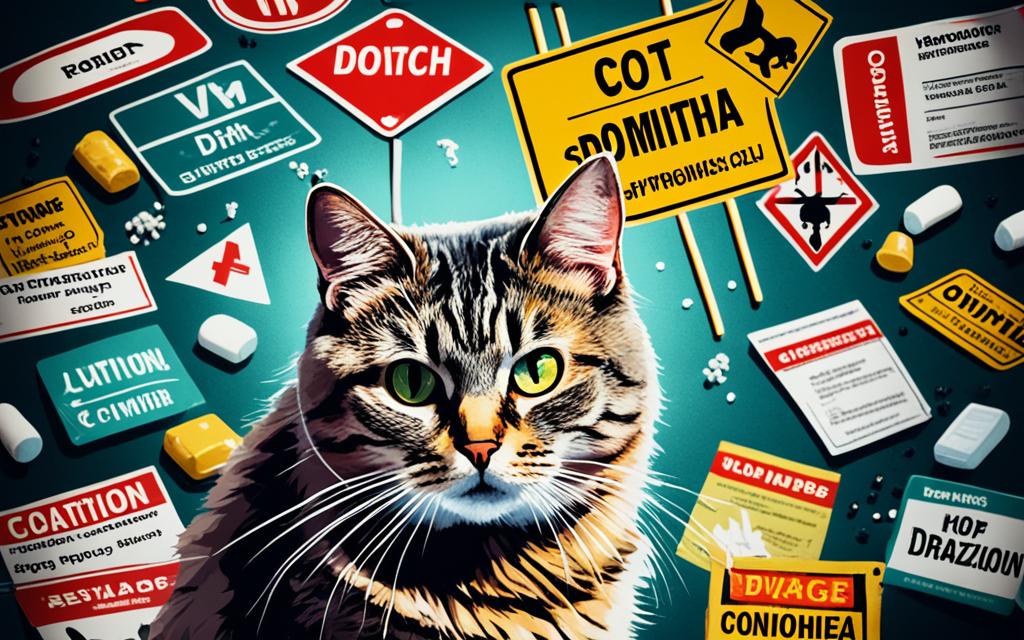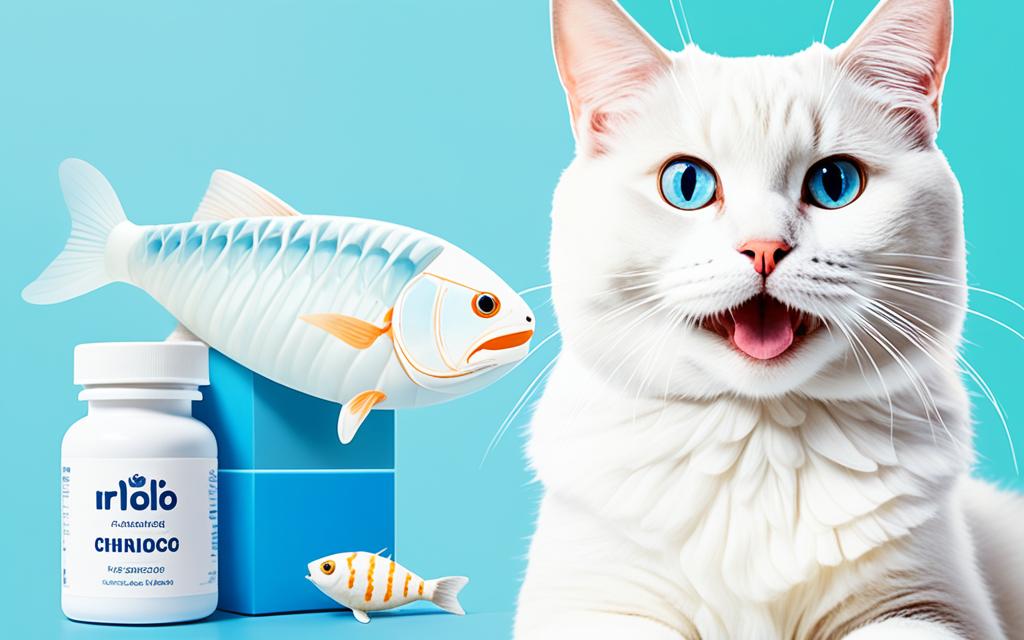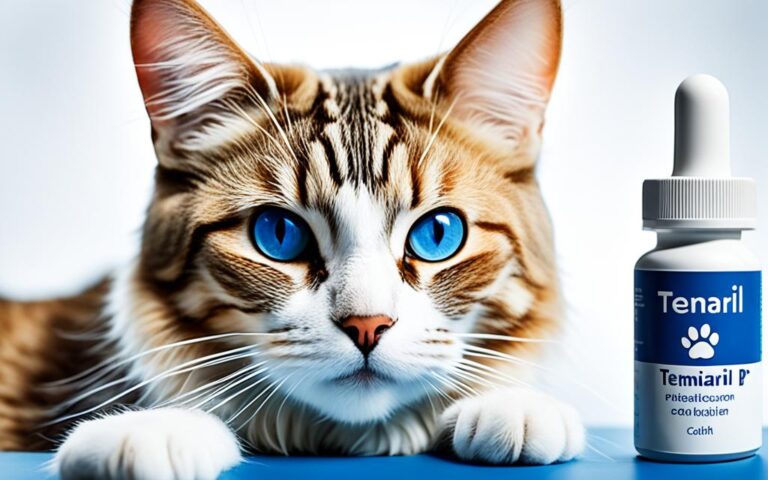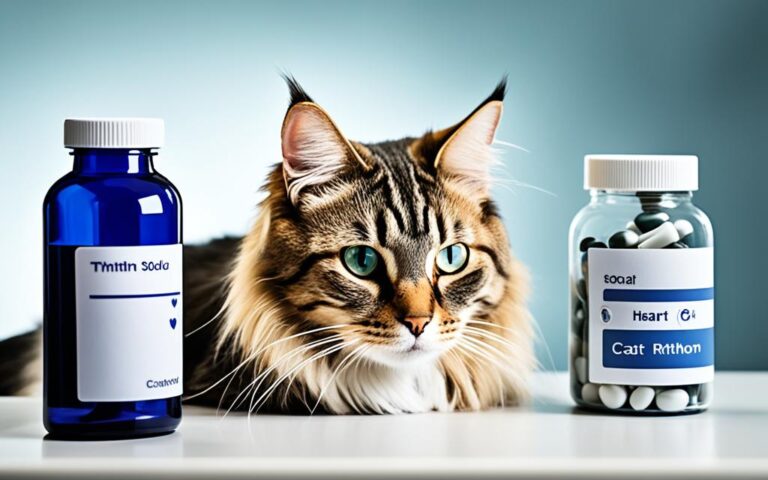Ronidazole for cats: Uses, Effects, and Safety Profile
Feline Tritrichomonas foetus is a common infection in cats worldwide. It varies in numbers in places like the UK, Switzerland, and others1. Some catteries have seen high cases, with 104 in Switzerland and 38 in Australia being noted1. Dealing with this protozoal issue has been hard for both cat owners and vets.
Key Takeaways
- Ronidazole is an antiprotozoal medication used to treat Tritrichomonas foetus infections in cats.
- Its use in cats and dogs is considered “off-label” or “extra-label” as it is not commercially available in the US or Canada.
- Potential side effects may include vomiting, decreased appetite, tremors, and more severe reactions.
- Ronidazole is potentially carcinogenic, and veterinarians have been cautioned about its use.
- Ronidazole should only be prescribed when T. foetus infection has been confirmed.
Table of Contents
What is Ronidazole?
Definition and Brand Names
Ronidazole is medication used to treat parasitic infections in pets, especially Tritrichomonas foetus in cats2. It is known by many names including Belga®, Ridsol-S®, and Ronida®2.
Off-Label Use in Veterinary Medicine
It is not officially sold in the United States or Canada for pets. But, some pharmacies can make it for veterinary needs3. Remember, it’s not meant for animals people eat3.
Ronidazole helps with various infections in cats and dogs2. However, its use is not directly approved in the U.S. or Canada2. Medications are specifically made for each pet when ‘compounded.’3.
This drug, Ronidazole, fights parasites by breaking down their DNA3. It’s good for Tritrichomonas in cats and Giardia in dogs3. The length of use can change depending on how the pet responds3.
“Ronidazole is the best for Tritrichomonas foetus infections, but some parasites might resist it.”4
Long-term use of this drug in dogs can hurt their testicles2. It’s also risky for people, linked to cancer in animals2.
Using Ronidazole in animals with seizures or that are pregnant needs careful thought2. And, for nursing pets, a milk replacer could be a better choice243.
How is Ronidazole Administered to Cats?
Dosage Form and Administration Route
Ronidazole is given to cats by mouth, usually in the form of capsules or a liquid5. Capsules come in different strengths, from 50 mg to 210 mg, and you can buy them in sets of 14, 28, or 565. It works best when taken with food. This helps avoid a possible upset stomach. If it’s a liquid form, owners must measure it carefully and wear gloves. The liquid should never be opened or smashed6.
Onset of Action and Clinical Improvements
Ronidazole starts to work within 1 to 2 days. You might see your cat feeling better not long after taking it6. Yet, be aware that mixed kinds of ronidazole might not work as well sometimes. This could be because the mix has less ronidazole or the way it’s released where it’s needed isn’t the best7.
| Metric | Value |
|---|---|
| Mean dose of intravenous RDZ administered | 9.2 mg/kg6 |
| Mean dose of immediate-release RDZ capsule administered | 28.2 mg/kg6 |
| Bioavailability of oral RDZ | 99.64%6 |
| Clearance of RDZ after IV administration | 0.82 ml/kg/min6 |
| Terminal half-life after IV administration | 9.80 h6 |
| Terminal half-life after oral administration | 10.50 h6 |
The data in the table tells us a lot about how ronidazole works in cats. It shows the amounts given, how well it’s used by the body, and for how long it stays in the system after being given by mouth or into a vein6.

“Ronidazole is commonly used in a 10% powder preparation to treat trichomoniasis in birds but the 100% pure chemical grade form is recommended for cats.”7
Always follow your vet’s advice on giving ronidazole. This will help your cat get the most benefit from it.
Missed Dose Guidelines
It’s key to follow the right ronidazole dosing regimen for your cat’s health. But sometimes, a dose may get skipped. In such cases, there are specific steps to take. These ensure your cat stays safe and gets the needed care.
If a dose of ronidazole is missed, here’s what to do. Try to give it as soon as you remember. But, if the next dose is coming up quickly, it’s better to skip the missed one. Then, just continue as normal to avoid giving too much medicine.8
Never double up on doses or give extra to catch up. This can harm your cat8. Just stick to the regular schedule. And, if worried, ask your vet for advice.
| Scenario | Recommended Action |
|---|---|
| You remember the missed dose shortly before the next scheduled dose | Skip the missed dose and give the medication at the next regular interval |
| You remember the missed dose significantly before the next scheduled dose | Give the missed dose as soon as you remember, then resume the regular dosing schedule |
| You accidentally give your cat two doses at once | Do not give an additional dose, resume the regular dosing schedule and contact your veterinarian |
Following these steps can help your cat benefit safely from ronidazole. Dosing consistency is vital for your pet’s well-being.
If you’re unsure about missed doses or how to give ronidazole, talk to your vet. They’re there to guide you. They’ll offer advice for the best care of your cat’s health.
Potential Side Effects and Precautions
Ronidazole can help with certain cat illnesses but can have side effects. It often causes cats to become less hungry, feel sick, and throw up9.
If things get worse, cats may show signs like being weak, moving strangely, twitching, or having seizures. Usually, these issues go away once the cat stops taking the medicine. However, it might take a few weeks for all signs to vanish9.
Serious Side Effects
In very rare cases, cats might get serious side effects from ronidazole. This could look like shaking, extreme tiredness, not wanting to eat, or having a hard time walking. They might also act strangely, run a fever, have seizures, get really weak, fall down, or show weird behaviors9.
Risk Factors and Contraindications
Ronidazole is a drug that could possibly cause cancer. So, the FDA limits its use in animals we get food from9. It’s risky for cats with a seizure history. For kittens, the dose should be small to prevent harm to their nerves9. Pregnant animals should never get this drug because it could hurt their babies9.
Ronidazole might react badly with other drugs, such as Cyclosporine. This can make side effects worse. If another drug slows down how ronidazole works, like Cimetidine does, it may also raise the risk of nerve damage9. Mixing it with certain drugs, like Oxytetracyclines, might be dangerous. There’s also a risk for bad effects if the animal on the medicine drinks alcohol or takes a certain type of blood thinner9.
If a cat eats too much ronidazole, quick action can help. Doctors might do things to make its stomach empty faster. Cats might need extra care if they show neurologic signs9.

“Ronidazole is more effective than tinidazole in treating T. foetus infection in cats according to Dr. Jody Gookin at the North Carolina State University.”10
Ronidazole is not an approved drug for cats. Only use it if the owner knows and signs off on it10.
| Prevalence of Tritrichomonas foetus in Cats | Effectiveness of Ronidazole Treatment |
|---|---|
| 10-15% overall prevalence in pet cats 31% of cats at a US cat show 30% in UK fecal samples from cats with diarrhea10 Young pedigree cats (particularly Siamese and Bengal) more likely to be infected in the UK | Ronidazole is the treatment of choice for Tritrichomonas foetus infections in cats Efficacy in treating clinical signs noted in most cats at recommended dosages Initial studies suggested a dose of 30-50mg/kg once to twice daily for two weeks can resolve clinical signs and potentially eradicate the infection However, this dosage can be associated with neurological side effects, occasional lethargy, and vomiting |
1011
Ronidazole for cats: Drug Interactions
When giving ronidazole to cats, vets must be careful because it can mix badly with other meds. Ronidazole is often used to treat protozoal infections in cats. But it can have bad effects when mixed with certain common drugs12.
The drug cimetidine is one example. It can slow down how ronidazole is broken down in the body. This might mean too much ronidazole stays in the cat’s system. That could make side effects more likely12. Ronidazole might also not work well with other drugs like cyclosporine and fluorouracil. This can change how well those drugs treat other health issues in the cat12.
Vets also need to watch out for bad combos with drugs like ketoconazole, lithium, and more12. If a cat is taking these along with ronidazole, their doses might need to be adjusted. Or they might need extra check-ups to make sure the treatment is safe and working right.
Pet owners should tell their vets about any drugs, vitamins, or herbs their cat is using. This helps the vet avoid risky interactions with ronidazole12.
Knowing the risks of mixing drugs with ronidazole helps vets keep your cat safe. They should always look at the cat’s full medication history. And watch closely while the cat is on ronidazole. This way, they can catch and avoid any problems, making sure the treatment really helps12132.
Monitoring During Ronidazole Treatment
When a cat is on ronidazole for Tritrichomonas, specific monitoring isn’t usually needed. The vet might, however, watch the cat closely to check if the medicine works well14. They could schedule regular visits and more tests to see how the cat is doing.
The vet often uses PCR tests to monitor treatment progress. This test is great for finding the parasite in poop samples1516. But, if a PCR test is negative, the infection might not be gone completely14.
Also, the vet might keep an eye on the cat’s poop and how their stomach is doing. They look out for side effects, like issues with the brain or nerves, which are possible with ronidazole16. They might even suggest keeping the cat away from others at home to avoid new infections14.
It’s key to remember that ronidazole usually works well against Tritrichomonas. Still, in some cats, the infection might stay14. Some studies even show that about 88% of cats will stop having diarrhea within two years, even without any treatment. This happens because the cat’s body can beat the infection alone sometimes14.
In the end, the vet plays a big part in making sure the cat’s ronidazole treatment is on track. They watch the cat’s health and might do more tests to be sure the medicine is doing its job. Regular visits and keeping an eye on how the cat is doing are all part of the plan141516.
Proper Storage of Ronidazole
Keeping ronidazole stored well is key for both its efficiency and your cat’s safety. The manufacturer has made an oral liquid form with strengths of 100 mg/mL and 200 mg/mL. It comes in different amounts like 15 mL, 20 mL, 30 mL, and 50 mL, or you can get a custom amount17.
Store ronidazole in the freezer in a secure container and shield it from light. Make sure to check the product label for any different storage directions17. The Northwest Compounders pharmacy provides free shipping. It’s certified to send medicines to certain states, including OR, WA, ID, ND, SD, WY, UT, CO, AZ, NM, MT, and AK. They are also working to get approval for shipping to TX and CA17.
When you order from Northwest Compounders, it usually arrives in 1 to 3 business days. There might be a few cases where it takes up to 4 days, especially for orders placed later than 4:30 pm. Check with the pharmacy if it’s okay to store the liquid medication outside the fridge17.
To get rid of ronidazole you don’t need anymore, it’s vital to use the right disposal steps. You can drop it off at certain places, take it to specific hazardous waste sites, or follow disposal guidelines at home17. Since compounded drugs are made just for you, they generally can’t be returned. Once they’ve made the medicine, you usually can’t get your money back17.
Sticking to the correct way to store and throw away ronidazole is crucial for your cat’s health and the drug’s power. Always talk to your vet or the pharmacy if you have any questions or are unsure about handling or storing this medicine17.
Emergency Procedures for Overdose or Adverse Reactions
If you think your pet has gotten too much ronidazole, call the vet right away18. If they’re closed, do what they told you to do in an emergency. It’s important to act fast to avoid serious problems. Look out for any odd signs in your pet after giving the medicine. Always make sure your pet is safe and well.
If there’s been too much medicine taken, the vet team might tell you what to do. This could include making your pet throw up or giving them activated charcoal19. For bad side effects like an upset stomach, acting differently, or changes in blood, your pet might need special care. The medicine might have to stop in those cases19. Quick action and the right care can help prevent things from getting worse. This way, your pet can get better quickly.
Pet owners need to watch their cats closely during ronidazole treatment1918. If you notice any problems, let your vet know right away. This early communication and working with the vet can keep your cat safe and well. Together, we can make sure ronidazole helps your cat without causing harm.
FAQ
What is Ronidazole?
What is the off-label use of Ronidazole in veterinary medicine?
How is Ronidazole administered to cats?
How soon can improvements in clinical signs be expected after starting Ronidazole?
What should I do if I miss a dose of Ronidazole?
What are the potential side effects of Ronidazole in cats?
Are there any precautions or contraindications for using Ronidazole in cats?
What drug interactions should I be aware of with Ronidazole?
What kind of monitoring is needed during Ronidazole treatment?
How should Ronidazole be stored?
What should I do in case of a Ronidazole overdose or adverse reaction?
Source Links
- Efficacy of guar gum-based ronidazole capsules as a treatment for Tritrichomonas foetus infection in cats
- Ronidazole | VCA Animal Hospitals
- Ronidazole for Dogs and Cats
- Ronidazole – an overview | ScienceDirect Topics
- Ronidazole Capsules | Northwest Compounders
- Ronidazole pharmacokinetics after intravenous and oral immediate-release capsule administration in healthy cats – PubMed
- Ronidazole treatment sheet for vets – 2009
- GUIDELINE for Tritrichomoniasis — ABCD cats & vets
- Uses, Dosage & Side Effects
- Tritrichomonas foetus infection in cats
- Neurotoxicosis in 4 Cats Receiving Ronidazole
- A Potent Antiprotozoal with Carcinogenic Concerns_Chemicalbook
- Tritrichomonas Infection Causes Diarrhea in Cats
- Approaching Tritrichomonas Foetus in Cats
- Fecal PCR test for Tritrichomonas foetus
- Ronidazole Oral Liquid | Northwest Compounders
- *
- How to manage feline chronic diarrhea, Part II: Treatment







